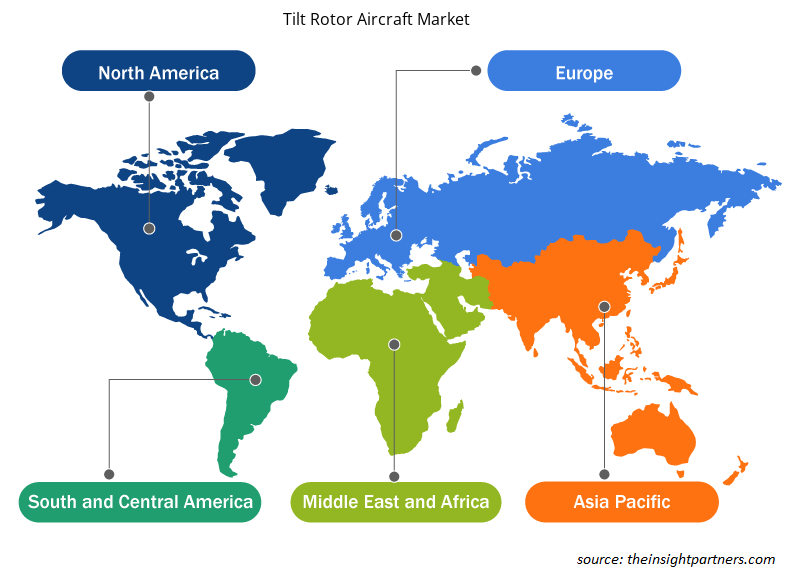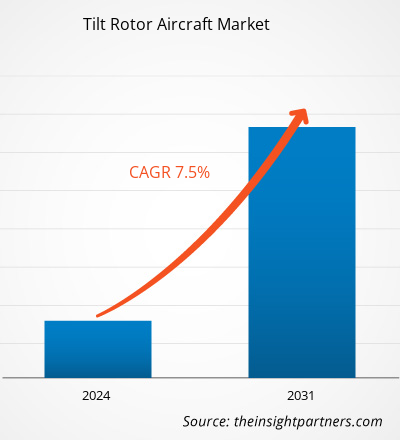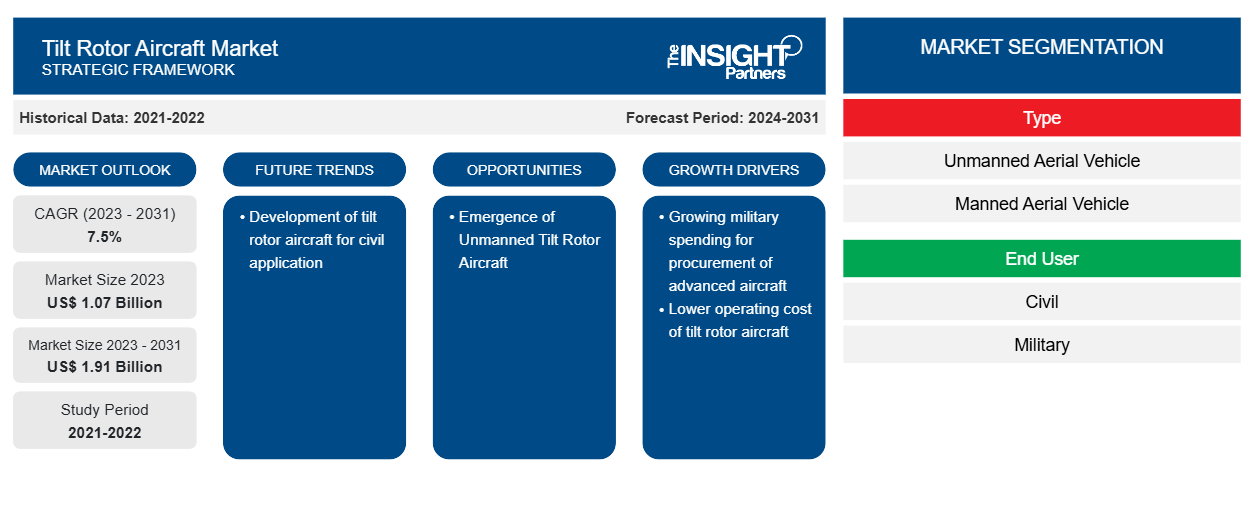Le marché des avions à rotor basculant devrait atteindre 1,91 milliard de dollars américains d'ici 2031, contre 1,07 milliard de dollars américains en 2023. Le marché devrait enregistrer un TCAC de 7,5 % au cours de la période 2023-2031. Le développement d'avions à rotor basculant pour les applications civiles devrait rester une tendance clé du marché.
Analyse du marché des avions à rotors basculants
Les acteurs du marché des avions à rotor basculant connaissent une croissance commerciale significative d'année en année. Cela est principalement attribué à l'augmentation du nombre d'utilisateurs finaux. L'augmentation des achats d'avions à rotor basculant pour les applications militaires et civiles favorise progressivement le pouvoir de négociation des fournisseurs. À l'heure actuelle, le pouvoir de négociation des fournisseurs d'avions à rotor basculant est modéré, mais il devrait tomber à des niveaux bas, car les utilisateurs finaux augmentent et les modèles sont construits avec des spécifications similaires. L'augmentation du nombre d'utilisateurs finaux est principalement liée à l'augmentation du développement de modèles d'avions à rotor basculant sans pilote pour les applications civiles et militaires.
Aperçu du marché des avions à rotors basculants
Les aéronefs à rotor basculant habités et les aéronefs à rotor basculant sans pilote sont les deux types d'aéronefs à rotor basculant habités proposés sur le marché. Le nombre de fabricants d'aéronefs à rotor basculant habités est relativement faible. À l'heure actuelle, les modèles d'aéronefs à rotor basculant habités sont disponibles auprès des forces de défense américaines et japonaises. Le coût des aéronefs à rotor basculant habités est l'un des principaux facteurs de la baisse de la demande. Cependant, avec la commercialisation de l'aéronef à rotor basculant AW609 de Leonardo, qui coûte environ 40 millions de dollars US de moins que le V-22 Osprey, cela encouragerait les acheteurs à se procurer des aéronefs à rotor basculant habités. Ce facteur est analysé pour comprendre et décrire le pouvoir de négociation des acheteurs dans les années à venir. De plus, les fournisseurs opérant sur le marché des aéronefs à rotor basculant se concentrent également principalement sur le développement de produits nouveaux et innovants pour rester compétitifs sur le marché.
Personnalisez ce rapport en fonction de vos besoins
Vous bénéficierez d'une personnalisation gratuite de n'importe quel rapport, y compris de certaines parties de ce rapport, d'une analyse au niveau des pays, d'un pack de données Excel, ainsi que de superbes offres et réductions pour les start-ups et les universités.
-
Obtenez les principales tendances clés du marché de ce rapport.Cet échantillon GRATUIT comprendra une analyse de données, allant des tendances du marché aux estimations et prévisions.
Moteurs et opportunités du marché des avions à rotors basculants
Dépenses militaires croissantes pour l'acquisition d'avions de pointe
Alors que les tensions mondiales persistent depuis quelques années, plusieurs pays concernés planifient et prennent des mesures pour améliorer et recapitaliser leur défense. Les menaces évoluent continuellement, passant de la force terrestre conventionnelle à la guerre hybride. Pour faire face aux menaces sécuritaires et lutter contre le terrorisme, les gouvernements de plusieurs pays ont déjà commencé à augmenter leurs budgets de défense. Selon l'Institut international de recherche sur la paix de Stockholm (SIPRI), les dépenses militaires mondiales ont atteint 2 443 milliards de dollars en 2023, ce qui représente une augmentation de 13,7 % par rapport à 2022.
Les tensions géopolitiques croissantes et les guerres entre certains pays de différentes régions entraînent des investissements importants dans le secteur de la défense. Une part importante de l'investissement est consacrée à l'acquisition d'avions militaires avancés et d'avions à rotor basculant. Par exemple, en mai 2023, Boeing a reçu un contrat d'une valeur de 482,3 millions de dollars US pour la production et la livraison de quatre avions CMV-22B (lot 27) pour les forces navales américaines. Ainsi, l'achat croissant d'avions à rotor basculant pour des applications militaires devrait stimuler la croissance du marché au cours de la période de prévision.
Apparition des aéronefs à rotor basculant sans pilote
L'évolution rapide de la guerre moderne a poussé les gouvernements à allouer des fonds plus importants aux forces armées respectives. L'allocation budgétaire militaire plus élevée permet aux forces militaires de s'engager dans le développement et l'acquisition de flottes de guerre avancées, y compris les drones. Le drone est largement utilisé pour la collecte de renseignements, la surveillance, la reconnaissance, l'acquisition de cibles, la gestion des dommages de combat, la livraison, le transport, les opérations de combat et d'autres applications. Les ministères du monde entier investissent des sommes importantes dans le but de moderniser les forces armées. À l'heure actuelle, la modernisation de la flotte est l'une des pratiques les plus observées suivies par l'industrie aérospatiale et de la défense. Des entreprises telles que Textron Inc., China Aerospace Science and Technology Corp. et BNA - Nurol BAE Systems Air Systems Inc. proposent des véhicules aériens sans pilote (UAV). Alors que l'avenir de la guerre aérienne passe progressivement des véhicules aériens habités aux véhicules aériens sans pilote, les acteurs du marché des avions à rotor basculant devraient connaître des opportunités de croissance importantes au cours de la période de prévision.
Analyse de segmentation du rapport sur le marché des avions à rotor inclinable
Les segments clés qui ont contribué à l’élaboration de l’analyse du marché des avions à rotor inclinable sont le type et l’utilisateur final.
- En fonction du type, le marché des aéronefs à rotor basculant est segmenté en véhicules aériens sans pilote et en véhicules aériens habités. Le segment des véhicules aériens habités détenait une part de marché plus importante en 2023.
- En fonction de l'utilisateur final, le marché des avions à rotor basculant est segmenté en civil et militaire. Le segment militaire détenait une part de marché plus importante en 2023.
Analyse des parts de marché des avions à rotors basculants par géographie
La portée géographique du rapport sur le marché des avions à rotor inclinable est principalement divisée en quatre régions : l’Amérique du Nord, l’Europe, l’Asie-Pacifique et le reste du monde.
L'Amérique du Nord a dominé le marché en 2023, suivie des régions Asie-Pacifique et Europe. En outre, l'Amérique du Nord devrait également connaître le TCAC le plus élevé dans les années à venir. Les États-Unis représentaient la plus grande part de marché sur le marché nord-américain des avions à rotor basculant. Les États-Unis sont le premier investisseur mondial en matière de défense et possèdent la plus grande flotte d'avions militaires au monde. Le gouvernement américain est également connu pour soutenir la recherche et le développement d'avions et de systèmes d'armement avancés. Actuellement, le pays possède la plus grande flotte d'avions à rotor basculant, le V-22 Osprey, qui est utilisé par l'US Air Force, l'US Navy et l'US Marine Corps. Le V-22 Osprey devrait continuer à dominer le marché des avions à rotor basculant au cours de la période de prévision. De plus, le pays est connu pour se procurer un grand nombre de véhicules aériens sans pilote avancés.
Aperçu régional du marché des avions à rotors basculants
Les tendances et facteurs régionaux influençant le marché des avions à rotor inclinable tout au long de la période de prévision ont été expliqués en détail par les analystes d’Insight Partners. Cette section traite également des segments et de la géographie du marché des avions à rotor inclinable en Amérique du Nord, en Europe, en Asie-Pacifique, au Moyen-Orient et en Afrique, ainsi qu’en Amérique du Sud et en Amérique centrale.

- Obtenez les données régionales spécifiques au marché des avions à rotor inclinable
Portée du rapport sur le marché des avions à rotor inclinable
| Attribut de rapport | Détails |
|---|---|
| Taille du marché en 2023 | 1,07 milliard de dollars américains |
| Taille du marché d'ici 2031 | 1,91 milliard de dollars américains |
| Taux de croissance annuel composé mondial (2023-2031) | 7,5% |
| Données historiques | 2021-2022 |
| Période de prévision | 2024-2031 |
| Segments couverts |
Par type
|
| Régions et pays couverts |
Amérique du Nord
|
| Leaders du marché et profils d'entreprises clés |
|
Densité des acteurs du marché des avions à rotors basculants : comprendre son impact sur la dynamique commerciale
Le marché des avions à rotor basculant connaît une croissance rapide, tirée par la demande croissante des utilisateurs finaux en raison de facteurs tels que l'évolution des préférences des consommateurs, les avancées technologiques et une plus grande sensibilisation aux avantages du produit. À mesure que la demande augmente, les entreprises élargissent leurs offres, innovent pour répondre aux besoins des consommateurs et capitalisent sur les tendances émergentes, ce qui alimente davantage la croissance du marché.
La densité des acteurs du marché fait référence à la répartition des entreprises ou des sociétés opérant sur un marché ou un secteur particulier. Elle indique le nombre de concurrents (acteurs du marché) présents sur un marché donné par rapport à sa taille ou à sa valeur marchande totale.
Les principales entreprises opérant sur le marché des avions à rotors basculants sont :
- BAE Systems plc
- Bell Textron Inc
- Boeing
- Industries aérospatiales israéliennes Ltd.
- Leonardo S.p.A.
- Société Lockheed Martin
Avis de non-responsabilité : les sociétés répertoriées ci-dessus ne sont pas classées dans un ordre particulier.

- Obtenez un aperçu des principaux acteurs du marché des avions à rotor inclinable
Actualités et développements récents du marché des avions à rotors basculants
Le marché des avions à rotor basculant est évalué en collectant des données qualitatives et quantitatives après des recherches primaires et secondaires, qui comprennent d'importantes publications d'entreprise, des données d'association et des bases de données. Quelques-uns des développements sur le marché des avions à rotor basculant sont énumérés ci-dessous :
- Textron Inc (NYSE : TXT) a annoncé aujourd'hui que Bell Textron Inc., une société Textron, s'est vu attribuer le contrat de développement du programme d'avion d'assaut à longue portée (FLRAA) de l'armée américaine. Ce contrat est basé sur le rotor basculant V-280 Valor de Bell qui a été développé et testé dans le cadre du programme JMR TD (Joint Multi-Role Technology Demonstrator) qui a débuté en 2013. Le V-280 a progressé grâce à la conception, à la fabrication et à plus de trois ans de tests en vol rigoureux qui ont fourni des données exhaustives validant les avantages techniques et opérationnels de l'avion pour la mission d'assaut à longue portée. (Source : Textron Inc, communiqué de presse, février 2022)
- La société russe ZALA Aero dévoile des drones à rotor inclinable et à propulsion hybride. Le VTOL à rotor inclinable ZALA combine les meilleures qualités d'un drone de type avion et d'un rotor inclinable, et a également la capacité de changer de configuration en fonction de la tâche à effectuer (Source : ZALA Aero, communiqué de presse, avril 2021)
Rapport sur le marché des avions à rotor inclinable et livrables
Le rapport « Taille et prévisions du marché des avions à rotor inclinable (2021-2031) » fournit une analyse détaillée du marché couvrant les domaines ci-dessous :
- Taille et prévisions du marché des avions à rotor inclinable aux niveaux mondial, régional et national pour tous les segments de marché clés couverts par le champ d'application
- Tendances du marché des avions à rotor inclinable ainsi que la dynamique du marché telles que les facteurs moteurs, les contraintes et les opportunités clés
- Analyse détaillée des cinq forces du porteur
- Analyse du marché des avions à rotor inclinable couvrant les principales tendances du marché, le cadre mondial et régional, les principaux acteurs, les réglementations et les développements récents du marché
- Analyse du paysage industriel et de la concurrence couvrant la concentration du marché, l'analyse de la carte thermique, les principaux acteurs et les développements récents pour le marché des avions à rotor inclinable
- Profils d'entreprise détaillés
- Analyse historique (2 ans), année de base, prévision (7 ans) avec TCAC
- Analyse PEST et SWOT
- Taille du marché Valeur / Volume - Mondial, Régional, Pays
- Industrie et paysage concurrentiel
- Ensemble de données Excel
Rapports récents
Témoignages
Raison d'acheter
- Prise de décision éclairée
- Compréhension de la dynamique du marché
- Analyse concurrentielle
- Connaissances clients
- Prévisions de marché
- Atténuation des risques
- Planification stratégique
- Justification des investissements
- Identification des marchés émergents
- Amélioration des stratégies marketing
- Amélioration de l'efficacité opérationnelle
- Alignement sur les tendances réglementaires























 Obtenez un échantillon gratuit pour - Marché des avions à rotors basculants
Obtenez un échantillon gratuit pour - Marché des avions à rotors basculants